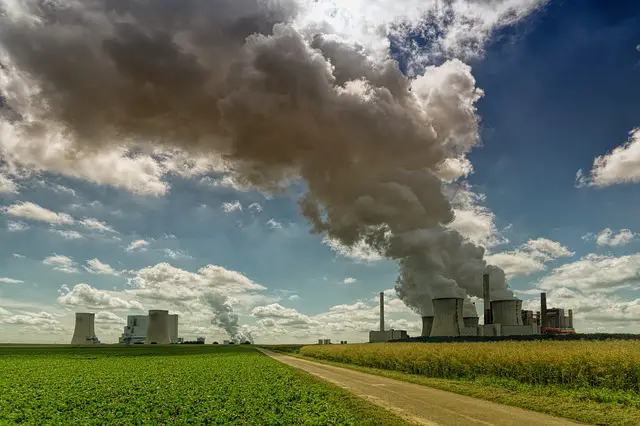We’ve previously written about the importance of coal to society – both in the past, and in the current day.
However, in the guide below, we summarise some of the top potential drawbacks of using coal as an energy source.
This guide may complement, and also be an extension of an overall guide we put together listing the pros and cons of coal energy.
Summary – Top Reasons Why Coal Might Be Bad
Some of the main reasons why coal might be bad as an energy source might include:
Air contaminants/pollutants can be emitted by the burning of coal
Potential impact of air pollution on human health
Potential cost of air pollution on the health system
Greenhouse gases can be emitted by the burning of coal
The burning of coal may contribute to acid rain
Coal mining may sometimes lead to a range of negative effects
Coal waste from power plants has to be treated and managed properly
Coal is considered a finite resource
Brown coal may have drawbacks as an energy source
‘Clean Coal’ technology may not really be clean, and has it’s own set of problems to consider
Thermal coal plants may use a lot of water
According To Some Indicators, Coal May Be One Of The Most Harmful Energy Sources
Some indicators of ‘harm’ may place coal as a more harmful and dangerous energy source than other fossil fuels, nuclear, and renewables.
We list and explain those indicators in this guide, and we also mention that coal may contribute to an increased risk of some human health problems, as well as be linked to mortality/deaths.
A brief summary of those indicators includes:
– Deaths caused by coal per unit of electricity produced (due to air pollution mainly)
– CO2 emissions
Total emissions, emissions during burning of the energy source, and emissions over the lifecycle of the energy source
– Potential harm caused to humans by mining of the energy source
– Potential harm caused to humans via exposure to, or as a result of dumping of the energy waste by-products
– Operational accidents (such power plant disasters)
– Potential for indirect harm from environmental issues caused by the energy source
Such as water pollution, soil contamination etc.
Burning Coal May Contribute To Air Pollution
Burning coal at power plants may release a range of air pollutants and contaminants.
This can lead to a decrease in air quality in the area where air pollution happens.
Potential Impact Of Air Pollution On Human Health
Specifically with health, there may be a link to lung and cardiovascular diseases.
There may also be a link in some instances to premature deaths from air pollution.
The energy sector and transport sector may be major contributors to air pollution amongst the different sectors in society.
Potential Cost Of Air Pollution To The Health System
There may be a financial cost of air pollution on the health system.
Beyond the health system cost, there may be resources and a financial cost that goes into treating and managing air pollution at the environmental level.
Greenhouse Gas Emissions From Burning Coal
Coal may be one of the highest emitters of greenhouse gases amongst energy sources
Having said this, some reports indicate that natural gas could come close to coal if you include methane leaks at the natural gas mining/extraction stage, and not just the burning of natural gas
Burning Coal May Lead To Acid Rain, Which May Lead To Environmental Issues
The chemicals that can be emitted during coal combustion can combine with other chemicals or elements in the air, and potentially lead to acid rain.
Acid rain can have it’s own potential negative effects in the environment.
Coal Mining May Have Negative Effects
Coal mining can sometimes result in land degradation, damage to wildlife and their habitats, and water pollution.
It may also sometimes displace local communities.
In some parts of the world, the working conditions for coal mining can sometimes come under question too.
Coal Waste Requires Treatment & Management
Burning coal produces waste such as coal ash.
Coal waste can build up as waste, so it needs to be treated and/or managed. There is a cost to do this.
It also contains heavy metals that can cause issues if leaked into the environment
Coal Is Considered A Finite Resource (& Not Renewable)
Coal is a finite resource.
This means that there are estimates on how much coal might be left in the world before we run out.
Comparatively, other energy sources like renewable energy are considered renewable as a resource.
The sun and wind for example might be considered renewable.
Brown Coal May Have Some Drawbacks As An Energy Source
This may mean that more brown coal has to be burnt in order to generate the same amount of energy as black coal.
‘Clean Coal’ Technology May Have Drawbacks
There are various forms of clean coal technology available.
However, despite the name, clean coal may not actually be ‘clean’, and may come with a range of potential drawbacks to consider.
As just a few examples:
– Clean coal can lead to more expensive electricity
– Significant money has been spent on some clean coal projects in the past, and some of them have eventually failed
Thermal Coal Plants Can Use A Lot Of Water
Thermal power plants are some of the largest users of water amongst different sectors of the economy.
Some reports indicate that other energy sources like solar and wind might be far less water intensive for energy production.
Read more in this guide about the water footprint of various energy production methods.
Sources
1. http://www.world-nuclear.org/information-library/energy-and-the-environment/clean-coal-technologies.aspx
2. https://en.wikipedia.org/wiki/Clean_coal_technology#Clean_coal_and_the_environment
3. https://www.bettermeetsreality.com/which-energy-source-is-the-most-dangerous-harmful-which-is-safest/
4. https://www.bettermeetsreality.com/summary-greenhouse-gas-emissions-united-states-past-present-future/
5. https://www.bettermeetsreality.com/breakdown-energy-use-production-united-states-now-future/
6. https://www.bettermeetsreality.com/breakdown-energy-use-production-in-china-now-future/
7. https://www.bettermeetsreality.com/the-challenges-with-chinas-transition-from-coal-to-natural-gas-renewable-energy/
8. https://www.bettermeetsreality.com/summary-greenhouse-gas-emissions-in-china-past-present-future/
9. https://www.bettermeetsreality.com/how-much-water-different-energy-electricity-production-sources-need-use-water-footprint/
10. https://unearthed.greenpeace.org/2014/08/28/five-reasons-expanding-brown-coal-mines-might-problem/
11. https://environmentvictoria.org.au/our-campaigns/safe-climate/problem-brown-coal/
12. https://www.theguardian.com/australia-news/2018/apr/03/coal-fired-power-stations-caused-surge-in-airborne-mercury-pollution-study-finds
13. http://butane.chem.uiuc.edu/pshapley/Enlist/Labs/AcidRain2/index.html
14. https://www.abc.net.au/news/2019-03-10/coal-ash-has-become-one-of-australias-biggest-waste-problems/10886866
15. http://www.tai.org.au/content/deconstructing-case-coal
16. https://ecowarriorprincess.net/2018/04/clean-coal-explained-what-it-is-and-is-it-really-sustainable/
17. https://www.abc.net.au/news/science/2019-04-01/coal-fired-power-emissions-mercury/10958128
','' ); } ?>